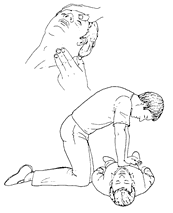| RESPIRATORY/ CARDIAC ARREST |
| Check if the person is unresponsive. Do this by shaking them and talking to them. If so call for help! Dial 999. Lie them flat and check that their airway is clear. Tiltthe head back and lift the chin. Remove any obvious obstructions from the mouth.  Check for breathing by observing chest movement, breathing Check for breathing by observing chest movement, breathingsounds and feeling for airflow. If breathing is not present, give the person two slow breaths. Do this by gently pinching their nose, thus closing the nostrils. Breathe in and place your mouth firmly over theirs. Breathe out slowly. Watch their chest rise as you exhale. Remove your mouth from theirs and allow their chest to fall again before you repeat this process.Check for heartbeat by feeling for pulse. Either the inside of the wrist, just above the base of the thumb. (Radial Pulse) Or, the neck, below the ear and level with the bottom of the jaw. (Carotid Pulse)  If heart beat is not present, begin cardiac massage. If heart beat is not present, begin cardiac massage.Measure two finger widths up from the base of the breast bone (Sternum)and place the palm of your hand above that point. Place your other hand on top of the first and clasp it between the fingers. Push down from your shoulders. Do not use excessive force as this could cause internal injury. The sternum should give about 2-3 inches. Pace yourself by counting aloud “one and,” “two and,” etc as you perform 15 compressions of the chest. If there are two people present, perform CPR at the ratio of 7 compressions followed by 1 inflation and repeat. If the person has stopped breathing, but has a pulse, only perform mouth to mouth. Finally, if spontaneous breathing and heartbeat should suddenly return, however unlikely, stop CPR. |
Common sense
Common sense is one of the best safety devices around. Unfortunately it does not seem to be that common.
Think about what you do!
Always try to differentiate between FANTASY and REALITY. Although the line separating the two can be very slim indeed, it can be the difference between a scene which is perfectly safe and one which is potentially very hazardous.
Try to be aware of who you are playing with, both physical and psychological responses are very important. Try to be aware of your scene. Think of what you have done, what you are doing and what you are going to do. When you think about these things, also think about the physical and psychological consequences of your actions.
Try to consider the physical and psychological limitations of your partner and also your self. It may be necessary to discuss these limits before embarking on a scene.
One of the limiting factors is knowledge, and one of the ways around this limit is sharing knowledge. For some activities, you must be competent as well as confident.
What do you need to know?
As well as a person’s sexual likes and dislikes, fetishes, etc, it also helps to know if someone is likely to drop dead on you, or has a medical problem which could be relevant to something you are about to do with them. Most people regard their personal medical details as something very intimate, but there are one or two conditions which warrant discussion. Even little things like false teeth or contact lenses can bring a very sudden downer on what could otherwise have been a good sex.
Examples; Anxiety attacks, Arthritis, Asthma or other respiratory disorder, Circulatory disorders, Diabetes, Heart disorders, Neurological disorders. The list is probably endless. You should know if you have a medical condition that your partner should be aware of. If you do not tell them about it, it could have unpleasant, or potentially fatal results. This can work both ways.
Some people feel that HIV status is a relevant topic for discussion, but if you are practising safer sex it seems a little irrelevant. However, other STDs might be worth mentioning to prevent your partner getting a dose.
Pain
Pain is the body’s way of telling you it has a problem, damage is being done! When you are hurting someone during a scene and they are enjoying the pain, if it changes or another pain becomes present the scene may be going wrong. If the bottom is experiencing pain which they are not enjoying, and you are not in control of that pain, you must stop the scene immediately and find out what is wrong.
Numbness/tingling/cramp
If something goes numb or tingly, it has probably been tied up too tightly, or in the wrong position. Release the bondage and massage the area. It should return to normal with five minutes. Cramp is due to reduced blood flow. This may also be caused by bondage being too tight or the positioning being wrong, but it can also be caused by sluggish blood flow due to immobility. In addition to the above, try flexing the affected area.
Coping with panic
Panic is the mind’s way of saying ‘Get me out of here’, so if a bottom panics that is the end of the scene. Stop the scene, release them from any bondage, and calm them down with a cuddle.
Fainting
Lack of oxygen or a drop in the blood pressure can result in fainting. If it’s the bottom, release them from any bondage. Check the person’s airway is clear, that they are breathing and have a pulse. If they are not breathing and/or do not have a pulse, call an ambulance and start CPR immediately. (See panel)
However if they are still alive, either sit the person down and place their head between their knees, or lie them down and slightly raise their feet, whichever is easiest. They should recover quite quickly.
Diabetes
Physical and mental stress results in an increase in metabolic function. In diabetics, this can result in Hypo-glycaemia (Low blood sugar). This can, with very little warning, cause the diabetic to lose consciousness. Common symptoms are profuse sweating and clamminess, sudden mood changes, appearing drunk, disorientation.
Unfortunately, just asking if they are OK will not always get a sensible response because the brain needs sugar to function properly.
Initial treatment is simple. Glucose! Any form as long as they do not choke on it. So give them some chocolate, a jam sandwich, glucose sweet, Lucozade, you name it.
Now get them lying down, keep them warm and continue feeding them glucose. If they worsen, or have not begun recovering within ten minutes dial 999.
Bleeding
Superficial bleeding will stop of its own accord; if you wish, apply antiseptic, but a good shower will probably do as much good. Injuries above the neck tend to bleed more then other areas of the body and this can make them seem worse than they actually are.
If someone is bleeding profusely, apply firm pressure to the injured area using a clean cloth.
If the bleeding does not stop, it may be necessary to visit the local Accident and Emergency department.
If the injury was caused by something dirty or an old piece of metal, it is a good idea to check that the person’s tetanus vaccinations are up to date.
Burn
You should only attempt to treat localised and superficial burns (First degree) yourself. Hold the injury under cold, running water or use an ice water compress (or a packet of frozen peas), until the pain subsides. Cover the area with a sterile, non adhesive dressing for a couple of days. If there is any sign of discharge, seek medical advice.
Other problems
If you are in any doubt, if you think there might be a broken limb or a spinal injury or concussion, just get the person to lie still, keep them warm and dial 999.
Do not worry, whatever you have been up to the staff will have seen worse and they are bound by confidentiality regulations not to repeat what they see. However because of the current legal situation in the UK regarding SM you would be well-advised to stick to describing the nature of the problem and not say anything about its cause.
Other problems which warrant a trip in an ambulance include any prolonged bleeding from the vagina, anus or urethra. Also the irretrievable loss of any items up any of the aforementioned orifices.
